Cooling Fabrics Market Size
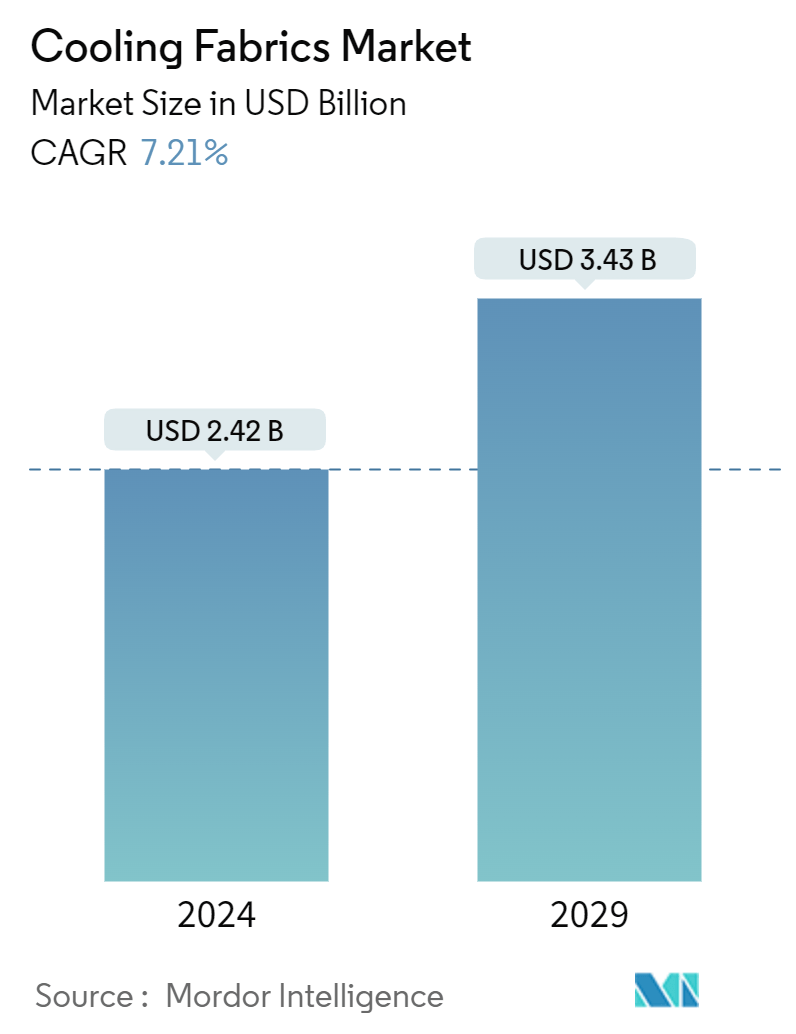
| Study Period | 2019 - 2029 |
| Market Size (2024) | USD 2.42 Billion |
| Market Size (2029) | USD 3.43 Billion |
| CAGR (2024 - 2029) | 7.21 % |
| Fastest Growing Market | Asia Pacific |
| Largest Market | North America |
Major Players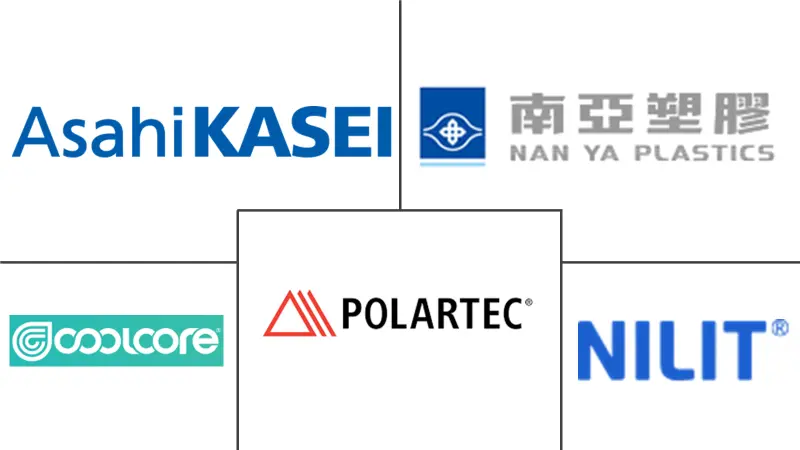
*Disclaimer: Major Players sorted in no particular order |
Cooling Fabrics Market Analysis
The Cooling Fabrics Market size is estimated at USD 2.42 billion in 2024, and is expected to reach USD 3.43 billion by 2029, growing at a CAGR of 7.21% during the forecast period (2024-2029).
The cooling fabrics market is gaining significant traction as the need for temperature-regulating materials across various industries, particularly in sportswear, continues to grow. Cooling fabrics are innovative textiles designed to dissipate heat, providing a cooling effect that is highly sought after in applications such as performance wear, protective clothing, and more. The market is driven by innovations in both natural and synthetic fabrics, with advancements in textile technology propelling the industry forward.
The market is characterized by its extensive application across different segments, notably sportswear, where the moisture-wicking and temperature-regulating properties of fabrics are crucial. The development of smart textiles and phase change materials has further enhanced the functionality of cooling fabrics, enabling them to adapt to changing environmental conditions and improve user comfort. As these technologies evolve, the cooling fabrics market is poised for significant growth.
Rising Demand for Sportswear Fuels Market Growth
- Enhanced Performance Needs: The increasing global focus on fitness and outdoor activities has led to a surge in demand for sportswear made from cooling textiles. Consumers now seek apparel that provides comfort while enhancing performance by maintaining optimal body temperature during intense physical activities. Innovations in moisture-wicking fabrics have become a key focus, catering to athletes and fitness enthusiasts who require high-performance sportswear.
- Integration of Smart Textiles: The incorporation of smart textiles into sportswear is a significant market driver. These textiles often include sensors and other technologies that offer functionalities like real-time monitoring of body temperature and moisture levels. This technological integration not only enhances the functionality of sportswear but also creates opportunities for manufacturers to offer premium products tailored to the specific needs of professional athletes.
- Broadening Applications: Cooling fabrics are expanding beyond traditional sportswear into sectors such as healthcare and military applications. In these fields, the ability to regulate temperature and provide comfort under extreme conditions is critical, broadening the market's scope and driving demand for advanced cooling textiles.
Challenges in Cost and Production
- High Production Costs: The production of advanced cooling fabrics involves specialized fibers and technologies that can drive up manufacturing costs. These high costs make cooling fabrics more expensive than conventional textiles, posing a barrier to wider adoption, especially in price-sensitive markets. Efforts to reduce production costs without compromising performance are crucial for expanding market reach.
- Market Penetration Issues: The higher price point of cooling fabrics impacts their penetration into mass markets. While there is significant demand in niche markets like professional sportswear and military applications, capturing the broader consumer market remains challenging due to price sensitivity. Manufacturers are focusing on innovations that reduce costs, aiming to make cooling fabrics more accessible to a wider audience.
- Supply Chain Complexities: The production of cooling fabrics involves a complex supply chain, including the sourcing of advanced materials and specialized manufacturing processes. Disruptions in this chain can lead to delays and increased costs, challenging market growth. Companies are working to streamline supply chains and establish partnerships to ensure a steady supply of materials and components necessary for producing cooling fabrics.
Cooling Fabrics Market Trends
Increasing Demand from Sportswear Application
- The sportswear industry is a major driver of the cooling fabrics market, fueled by the growing global interest in fitness and outdoor activities. Athletes and active individuals demand apparel that enhances performance through body temperature regulation, a need effectively met by cooling textiles. Moisture-wicking fabrics are now essential in high-performance sportswear, helping maintain optimal body temperature during intense activities.
- Thermoregulation for Enhanced Performance: Cooling fabrics excel in managing moisture and heat, crucial for athletic performance. By wicking away sweat and facilitating rapid evaporation, these materials help keep the body cool, preventing overheating during exercise. This capability is especially valuable in sports where maintaining a stable body temperature directly impacts performance, making advanced cooling technology a standard in premium sportswear collections.
- Integration of Smart Textiles and Phase Change Materials: Innovation is further driving demand, with smart textiles and phase change materials becoming more prevalent in sportswear. These technologies allow fabrics to dynamically respond to changes in body temperature, offering personalized cooling effects. For instance, phase change materials can absorb excess body heat and release it when the body cools down, providing consistent thermoregulation, which is particularly beneficial for athletes needing reliable temperature control.
- Sustainability Trends in Sportswear: The market's shift towards sustainability is also influencing the adoption of cooling fabrics. Manufacturers increasingly use eco-friendly materials to produce breathable, high-performance fabrics without compromising functionality. This aligns with broader industry trends focused on sustainability and ethical production, further propelling the growth of cooling textiles within the sportswear sector.
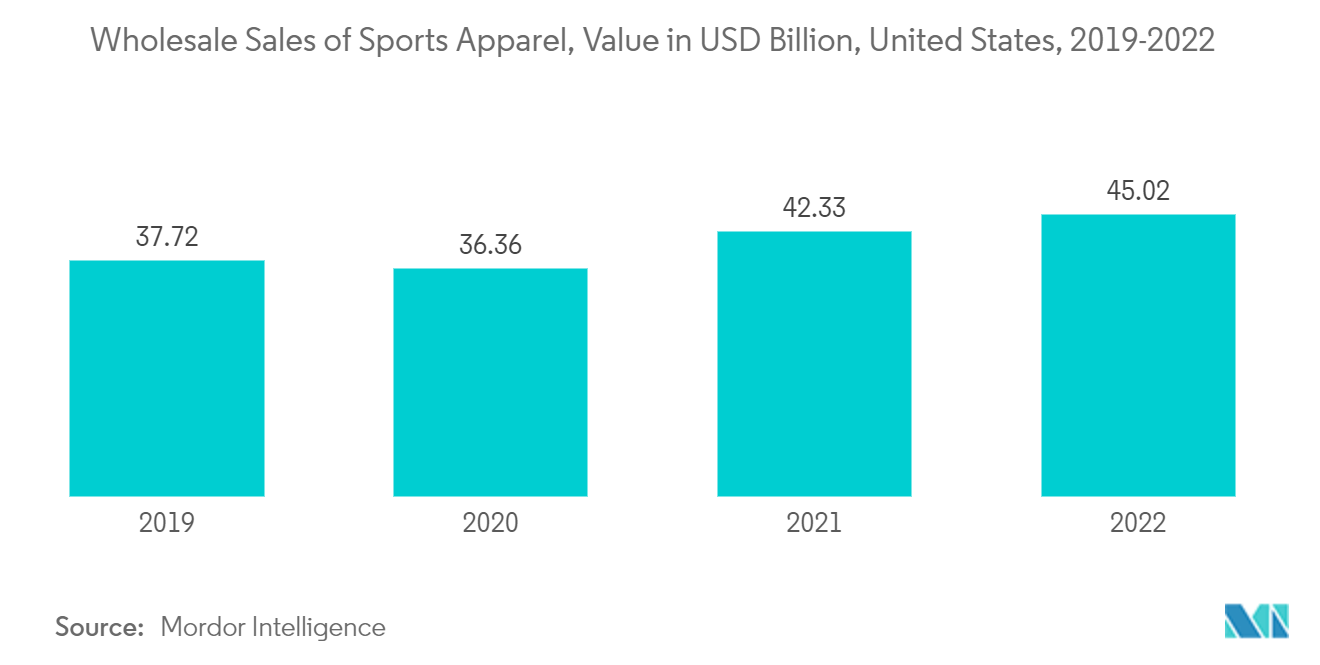
North America to Dominate the Market
- North America leads the global cooling fabrics market, driven by its advanced textile industry and high consumer demand for functional, high-performance apparel. The U.S. is at the forefront, with significant investments in R&D leading to innovative cooling fabrics that cater to the needs of both professional athletes and health-conscious consumers.
- Health and Fitness Culture Driving Demand: The strong health and fitness culture in North America significantly contributes to the market's expansion. Consumers increasingly seek apparel that combines comfort with advanced functionality, driving widespread adoption of temperature-regulating fabrics in various clothing lines. The availability of comprehensive industry research and market data further supports consumer interest, fueling market growth in the region.
- Expansion Beyond Sportswear: Beyond sportswear, the adoption of cooling fabrics is growing in other sectors such as casual wear, outdoor gear, and medical textiles. The region's favorable market conditions, including a robust retail network and high disposable income, create an ideal environment for the proliferation of advanced textiles. This broadening application range solidifies North America's position as a market leader.
- Sustained Market Growth Forecast: The outlook for cooling fabrics in North America remains positive, with sustained market growth expected. The presence of major market leaders who continually innovate and expand product lines, including UV-protective and heat-resistant fabrics, ensures that the region remains at the cutting edge of the industry. Strong distribution channels and rapid adaptation to emerging trends further reinforce North America's dominant market position, with the market value anticipated to rise steadily.
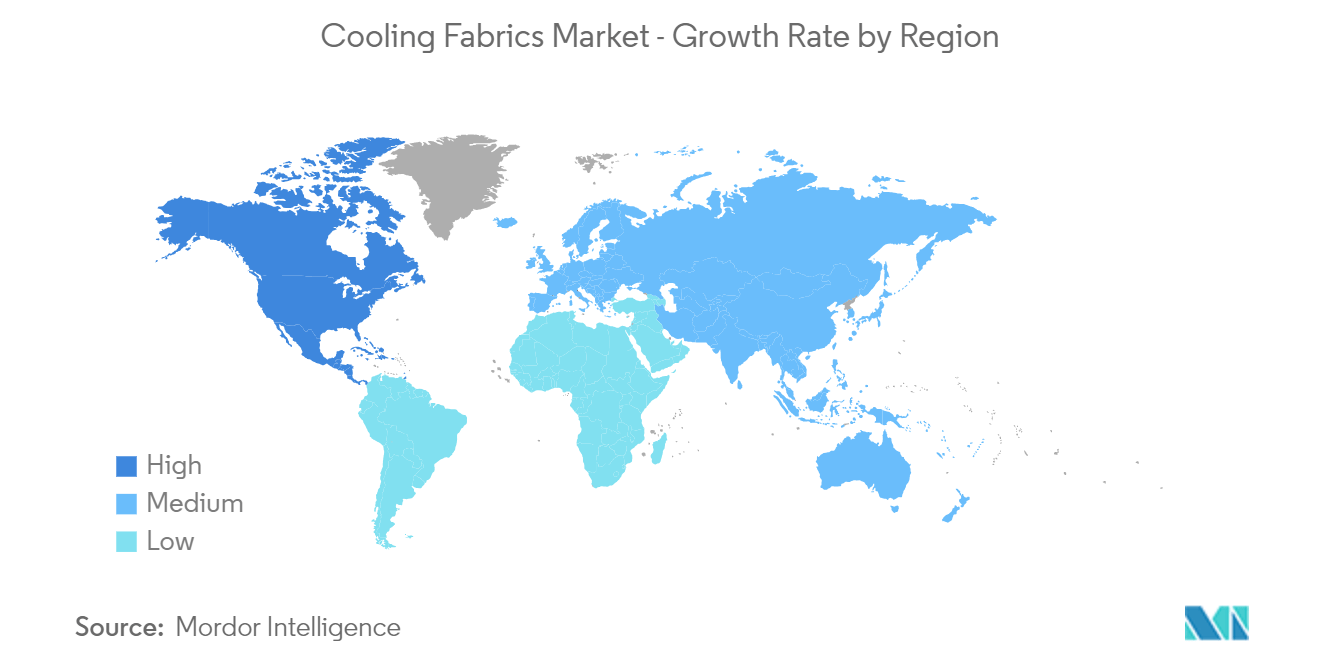
Cooling Fabrics Industry Overview
- Fragmented Market Structure: The cooling fabrics market is characterized by a fragmented landscape, with a diverse range of companies operating globally. This market consists of both large multinational corporations and smaller, specialized players. While no single company holds a dominant market share, leading firms maintain a competitive edge through innovation and strategic partnerships. The fragmented nature of this market means that companies need to continuously innovate to differentiate their offerings and capture market share.
- Prominent Market Leaders: The major players in the cooling fabrics market include Asahi Kasei Corporation, Coolcore, Polartec, NILIT, and NAN YA PLASTICS CORPORATION. These companies are recognized for their strong product portfolios, extensive R&D investments, and global presence. Their strengths lie in advanced fabric technologies, diversified applications across industries, and a strong brand reputation. These companies leverage their global operations to meet the increasing demand for cooling fabrics in various regions.
- Factors for Future Success: The cooling fabrics market is driven by innovation in fabric technology and sustainable production processes. To succeed, companies need to focus on developing eco-friendly products and enhancing the performance characteristics of their fabrics, such as moisture-wicking, breathability, and durability. Strategic collaborations with sportswear brands and other end-use industries will also be crucial for expanding market reach and maintaining competitiveness.
- Strategic Partnerships and Innovations: Leading companies in the cooling fabrics market are increasingly focusing on strategic partnerships and innovations to maintain their competitive edge. Collaborations with technology firms and sportswear brands are paving the way for the development of next-generation cooling fabrics. These partnerships are essential for integrating advanced cooling technology into a broader range of applications, from sportswear to protective gear, ensuring continued market leadership.
Cooling Fabrics Market Leaders
-
Asahi Kasei Corporation
-
Coolcore
-
Polartec
-
NILIT
-
NAN YA PLASTICS CORPORATION
*Disclaimer: Major Players sorted in no particular order
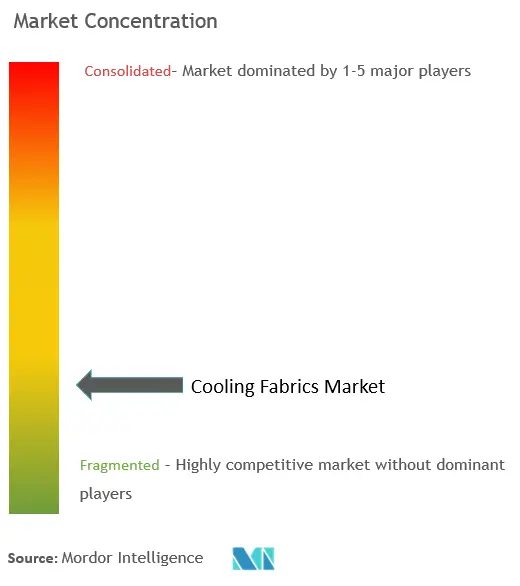
Cooling Fabrics Market News
- January 2023: NILIT launched a new version of SENSIL EcoCare recycled Nylon 6.6 manufactured completely from US materials at its North American facility in Martinsville, VA.
- March 2023: NILIT earned the International Sustainability and Carbon Certification Plus system (ISCC+) accreditation for its primary brand SENSIL ByNature, which manufactures cooling fabrics.
Cooling Fabrics Market Report - Table of Contents
1. INTRODUCTION
- 1.1 Study Assumptions
- 1.2 Scope of the Study
2. RESEARCH METHODOLOGY
3. EXECUTIVE SUMMARY
4. MARKET DYNAMICS
-
4.1 Drivers
- 4.1.1 Growing Demand for Synthetic Fabrics
- 4.1.2 Increasing Demand for Sportwear Fabrics
- 4.1.3 Other Drivers
-
4.2 Restraints
- 4.2.1 High Cost of Cooling Fabrics
- 4.2.2 Other Restraints
- 4.3 Industry Value Chain Analysis
-
4.4 Porter's Five Forces Analysis
- 4.4.1 Bargaining Power of Suppliers
- 4.4.2 Bargaining Power of Buyers
- 4.4.3 Threat of New Entrants
- 4.4.4 Threat of Substitute Products and Services
- 4.4.5 Degree of Competition
5. MARKET SEGMENTATION (Market Size in Value)
-
5.1 Type
- 5.1.1 Natural
- 5.1.2 Synthetic
-
5.2 Fabric Type
- 5.2.1 Woven
- 5.2.2 Non-woven
- 5.2.3 Knitted
-
5.3 Application
- 5.3.1 Sportswear
- 5.3.2 Protective Wear
- 5.3.3 Apparels
- 5.3.4 Others (Medical, etc.)
-
5.4 Geography
- 5.4.1 Asia-Pacific
- 5.4.1.1 China
- 5.4.1.2 India
- 5.4.1.3 Japan
- 5.4.1.4 South Korea
- 5.4.1.5 Rest of Asia-Pacific
- 5.4.2 North America
- 5.4.2.1 United States
- 5.4.2.2 Canada
- 5.4.2.3 Mexico
- 5.4.3 Europe
- 5.4.3.1 Germany
- 5.4.3.2 United Kingdom
- 5.4.3.3 Italy
- 5.4.3.4 France
- 5.4.3.5 Rest of Europe
- 5.4.4 South America
- 5.4.4.1 Brazil
- 5.4.4.2 Argentina
- 5.4.4.3 Rest of South America
- 5.4.5 Middle East and Africa
- 5.4.5.1 Saudi Arabia
- 5.4.5.2 South Africa
- 5.4.5.3 Rest of Middle East and Africa
6. COMPETITIVE LANDSCAPE
- 6.1 Mergers and Acquisitions, Joint Ventures, Collaborations, and Agreements
- 6.2 Market Share (%)**/Ranking Analysis
- 6.3 Strategies Adopted by Leading Players
-
6.4 Company Profiles
- 6.4.1 Asahi Kasei Corporation
- 6.4.2 Balavigna Weaving Mills Pvt. Ltd.
- 6.4.3 Burlington
- 6.4.4 Columbia Sportswear Company
- 6.4.5 Coolcore
- 6.4.6 Everest Textile Co., Ltd.
- 6.4.7 Formosa Taffeta Co., Ltd.
- 6.4.8 HeiQ Materials AG
- 6.4.9 NAN YA PLASTICS CORPORATION
- 6.4.10 NILIT
- 6.4.11 Polartec
- 6.4.12 Wilson Fabrics
- *List Not Exhaustive
7. MARKET OPPORTUNITIES AND FUTURE TRENDS
- 7.1 Growing Applications in Defense Industry
- 7.2 Other Opportunities
Cooling Fabrics Industry Segmentation
Cooling fabrics are breathable fabric, which allows air to circulate and flow through the fabric. Cooling fabrics absorb heat from the body to help keep the temperature cool. These fabrics are widely used by healthcare professionals, athletes, and others. These fabrics draw moisture away from the body while sweating to help in lowering body temperature and prevent dehydration.
The cooling fabrics market is segmented by type, fabric type, application, and geography. By type, the market is segmented into natural and synthetic. By fabric type, the market is segmented into woven, non-woven, and knitted. By application, the market is segmented into sportswear, protective wear, apparel, and others (medical, etc.). The report also covers the market size and forecasts for the market in 15 countries across the globe. For each segment, the market sizing and forecasts have been done on the basis of value (USD).
| Type | Natural | |
| Synthetic | ||
| Fabric Type | Woven | |
| Non-woven | ||
| Knitted | ||
| Application | Sportswear | |
| Protective Wear | ||
| Apparels | ||
| Others (Medical, etc.) | ||
| Geography | Asia-Pacific | China |
| India | ||
| Japan | ||
| South Korea | ||
| Rest of Asia-Pacific | ||
| Geography | North America | United States |
| Canada | ||
| Mexico | ||
| Geography | Europe | Germany |
| United Kingdom | ||
| Italy | ||
| France | ||
| Rest of Europe | ||
| Geography | South America | Brazil |
| Argentina | ||
| Rest of South America | ||
| Geography | Middle East and Africa | Saudi Arabia |
| South Africa | ||
| Rest of Middle East and Africa |
Cooling Fabrics Market Research FAQs
How big is the Cooling Fabrics Market?
The Cooling Fabrics Market size is expected to reach USD 2.42 billion in 2024 and grow at a CAGR of 7.21% to reach USD 3.43 billion by 2029.
What is the current Cooling Fabrics Market size?
In 2024, the Cooling Fabrics Market size is expected to reach USD 2.42 billion.
Who are the key players in Cooling Fabrics Market?
Asahi Kasei Corporation, Coolcore, Polartec, NILIT and NAN YA PLASTICS CORPORATION are the major companies operating in the Cooling Fabrics Market.
Which is the fastest growing region in Cooling Fabrics Market?
Asia Pacific is estimated to grow at the highest CAGR over the forecast period (2024-2029).
Which region has the biggest share in Cooling Fabrics Market?
In 2024, the North America accounts for the largest market share in Cooling Fabrics Market.
What years does this Cooling Fabrics Market cover, and what was the market size in 2023?
In 2023, the Cooling Fabrics Market size was estimated at USD 2.25 billion. The report covers the Cooling Fabrics Market historical market size for years: 2019, 2020, 2021, 2022 and 2023. The report also forecasts the Cooling Fabrics Market size for years: 2024, 2025, 2026, 2027, 2028 and 2029.
Textile Fabrics Industry Report
Our comprehensive Cooling Fabrics Market Research report provides an in-depth analysis of the evolving trends, technologies, and key drivers shaping the market landscape. This report covers a broad spectrum of industry dynamics, including the integration of smart textiles, advancements in phase change materials, and the growing demand for thermoregulating materials across various applications such as sportswear, healthcare, and protective gear. Stakeholders will gain valuable insights into the market's competitive landscape, including strategies adopted by leading players to innovate and capture emerging opportunities. All findings and projections are thoroughly documented in an easy-to-access report pdf format, ensuring clarity and actionable intelligence.
This report serves as an essential tool for industry leaders, offering detailed market research that highlights the latest advancements in cooling technology and the growing adoption of moisture-wicking fabrics. By providing key data on market size, segmentation, and growth prospects, our report empowers stakeholders to make informed decisions, capitalize on market trends, and identify potential areas for expansion. Additionally, the report addresses the challenges of production costs and supply chain complexities, offering strategies to navigate these hurdles. With a strong emphasis on industry analysis and market forecasts, this report is designed to equip businesses with the knowledge needed to maintain a competitive edge in the rapidly expanding cooling fabrics market.
Statistics for the 2024 Cooling Fabrics market share, size and revenue growth rate, created by Mordor Intelligence™ Industry Reports. Cooling Fabrics analysis includes a market forecast outlook to for 2024 to 2029 and historical overview. Get a sample of this industry analysis as a free report PDF download.



